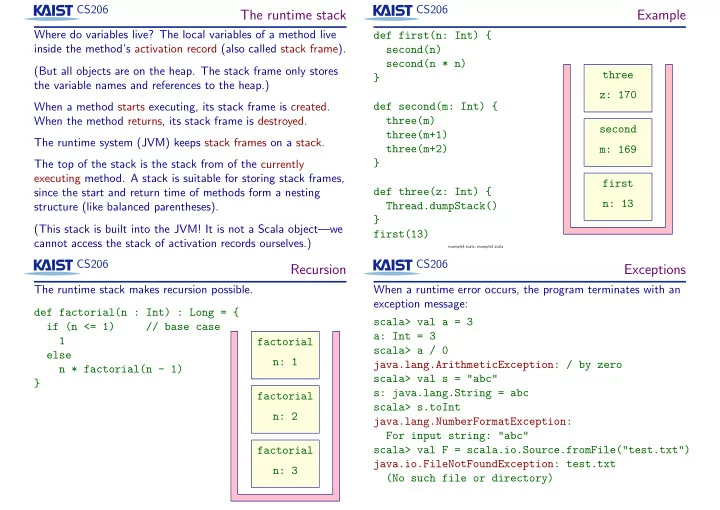

CS206 CS206 Example The runtime stack Where do variables live? The local variables of a method live def first(n: Int) { inside the method’s activation record (also called stack frame). second(n) second(n * n) (But all objects are on the heap. The stack frame only stores three } the variable names and references to the heap.) z: 170 When a method starts executing, its stack frame is created. def second(m: Int) { When the method returns, its stack frame is destroyed. three(m) second three(m+1) The runtime system (JVM) keeps stack frames on a stack. three(m+2) m: 169 The top of the stack is the stack from of the currently } executing method. A stack is suitable for storing stack frames, first def three(z: Int) { since the start and return time of methods form a nesting n: 13 Thread.dumpStack() structure (like balanced parentheses). } (This stack is built into the JVM! It is not a Scala object—we first(13) cannot access the stack of activation records ourselves.) example1.scala, example2.scala CS206 CS206 Recursion Exceptions The runtime stack makes recursion possible. When a runtime error occurs, the program terminates with an exception message: def factorial(n : Int) : Long = { scala> val a = 3 if (n <= 1) // base case a: Int = 3 1 factorial scala> a / 0 else n: 1 java.lang.ArithmeticException: / by zero n * factorial(n - 1) scala> val s = "abc" } s: java.lang.String = abc factorial scala> s.toInt n: 2 java.lang.NumberFormatException: For input string: "abc" scala> val F = scala.io.Source.fromFile("test.txt") factorial java.io.FileNotFoundException: test.txt n: 3 (No such file or directory)
CS206 CS206 Handling exceptions Catching across function calls If an exception occurs inside a try clause, execution continues def test(s: String): Int = { with a matching exception handler in the catch clause: (s.toDouble * 100).toInt } val str = readLine("Enter a number> ") def show(s: String) { try { try { val x = str.toInt println(test(s)) printf("You said: %d\n", x) } catch { } catch { case e: NumberFormatException => case e: NumberFormatException => println("Incorrect input") printf("’%s’ is not a number\n", str); } } } Exceptions keep the interface of the method toInt clean. scala> show("123.456") (Compare the C function strtol .) 12345 scala> show("123a456") Incorrect input catch1.scala catch2.scala CS206 CS206 Handling exceptions Throwing exceptions If an exception occurs, the normal flow of control is When we detect an error in the input data, we can throw an interrupted. Execution continues in the innermost catch block exception ourselves: with a matching exception handler. if (n < 0) def f(n: Int) = g(n) throw new IllegalArgumentException except2.scala Exceptions are often used to detect errors in the input data. def g(n: Int) { val m = 100 / n We can catch the exception at a suitable place in the program printf("The result is %d\n", m) and print an error message, or handle the problem in some } other way. try { The exception may happen deep inside several function calls: f(n) } catch { Welcome to KAIST SuperCalculator! case e: ArithmeticException > 3 + 5 * (12.0 + (4 + 6.0 * @)) => println("I can’t handle this value!") Syntax error } except1.scala
CS206 Throwing exceptions Exceptions are Scala objects derived from Exception : class SyntaxError extends Exception When we detect a situation that we cannot handle locally, we can throw an exception: if (!tok.token.isSymbol(")")) throw new SyntaxError Exceptions are normal objects and can have additional fields and methods. calculator3.scala
Recommend
More recommend